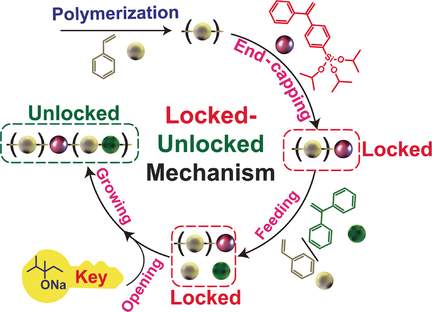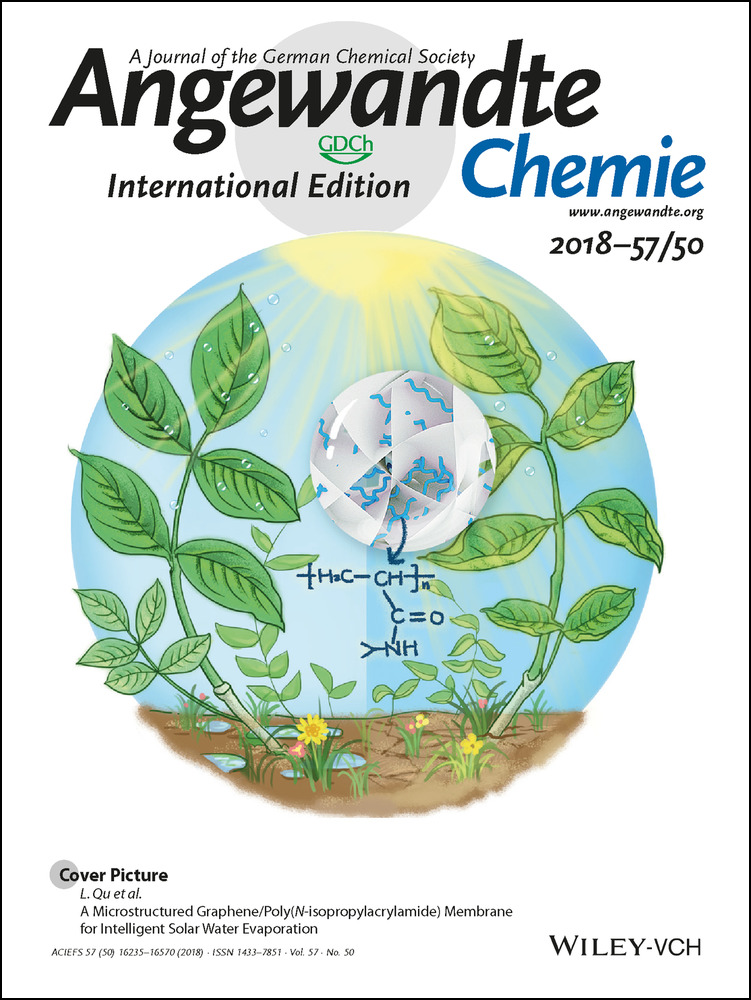Investigation of the Locked-Unlocked Mechanism in Living Anionic Polymerization Realized with 1-(Tri-isopropoxymethylsilylphenyl)-1-phenylethylene
Pibo Liu
State Key Laboratory of Fine Chemicals, Department of Polymer Science and Engineering, Liaoning Key Laboratory of Polymer Science and Engineering, School of Chemical Engineering, Dalian University of Technology, Dalian, 116024 China
Search for more papers by this authorCorresponding Author
Hongwei Ma
State Key Laboratory of Fine Chemicals, Department of Polymer Science and Engineering, Liaoning Key Laboratory of Polymer Science and Engineering, School of Chemical Engineering, Dalian University of Technology, Dalian, 116024 China
Search for more papers by this authorLi Han
State Key Laboratory of Fine Chemicals, Department of Polymer Science and Engineering, Liaoning Key Laboratory of Polymer Science and Engineering, School of Chemical Engineering, Dalian University of Technology, Dalian, 116024 China
Search for more papers by this authorHeyu Shen
State Key Laboratory of Fine Chemicals, Department of Polymer Science and Engineering, Liaoning Key Laboratory of Polymer Science and Engineering, School of Chemical Engineering, Dalian University of Technology, Dalian, 116024 China
Search for more papers by this authorLincan Yang
State Key Laboratory of Fine Chemicals, Department of Polymer Science and Engineering, Liaoning Key Laboratory of Polymer Science and Engineering, School of Chemical Engineering, Dalian University of Technology, Dalian, 116024 China
Search for more papers by this authorChao Li
State Key Laboratory of Fine Chemicals, Department of Polymer Science and Engineering, Liaoning Key Laboratory of Polymer Science and Engineering, School of Chemical Engineering, Dalian University of Technology, Dalian, 116024 China
Search for more papers by this authorXinyu Hao
State Key Laboratory of Fine Chemicals, Department of Polymer Science and Engineering, Liaoning Key Laboratory of Polymer Science and Engineering, School of Chemical Engineering, Dalian University of Technology, Dalian, 116024 China
Search for more papers by this authorYang Li
State Key Laboratory of Fine Chemicals, Department of Polymer Science and Engineering, Liaoning Key Laboratory of Polymer Science and Engineering, School of Chemical Engineering, Dalian University of Technology, Dalian, 116024 China
Search for more papers by this authorPibo Liu
State Key Laboratory of Fine Chemicals, Department of Polymer Science and Engineering, Liaoning Key Laboratory of Polymer Science and Engineering, School of Chemical Engineering, Dalian University of Technology, Dalian, 116024 China
Search for more papers by this authorCorresponding Author
Hongwei Ma
State Key Laboratory of Fine Chemicals, Department of Polymer Science and Engineering, Liaoning Key Laboratory of Polymer Science and Engineering, School of Chemical Engineering, Dalian University of Technology, Dalian, 116024 China
Search for more papers by this authorLi Han
State Key Laboratory of Fine Chemicals, Department of Polymer Science and Engineering, Liaoning Key Laboratory of Polymer Science and Engineering, School of Chemical Engineering, Dalian University of Technology, Dalian, 116024 China
Search for more papers by this authorHeyu Shen
State Key Laboratory of Fine Chemicals, Department of Polymer Science and Engineering, Liaoning Key Laboratory of Polymer Science and Engineering, School of Chemical Engineering, Dalian University of Technology, Dalian, 116024 China
Search for more papers by this authorLincan Yang
State Key Laboratory of Fine Chemicals, Department of Polymer Science and Engineering, Liaoning Key Laboratory of Polymer Science and Engineering, School of Chemical Engineering, Dalian University of Technology, Dalian, 116024 China
Search for more papers by this authorChao Li
State Key Laboratory of Fine Chemicals, Department of Polymer Science and Engineering, Liaoning Key Laboratory of Polymer Science and Engineering, School of Chemical Engineering, Dalian University of Technology, Dalian, 116024 China
Search for more papers by this authorXinyu Hao
State Key Laboratory of Fine Chemicals, Department of Polymer Science and Engineering, Liaoning Key Laboratory of Polymer Science and Engineering, School of Chemical Engineering, Dalian University of Technology, Dalian, 116024 China
Search for more papers by this authorYang Li
State Key Laboratory of Fine Chemicals, Department of Polymer Science and Engineering, Liaoning Key Laboratory of Polymer Science and Engineering, School of Chemical Engineering, Dalian University of Technology, Dalian, 116024 China
Search for more papers by this authorGraphical Abstract
Locked in: An intriguing advance in living anionic polymerization (LAP) by a “locked-unlocked” mechanism was investigated. The living anionic species can be quantitatively locked by end-capping with 1-(tri-isopropoxymethylsilylphenyl)-1-phenylethylene (DPE-Si(O-iPr)3) and can be unlocked by adding the key, sodium 2,3-dimethylpentan-3-olate (NaODP).
Abstract
Reported is an intriguing advance in living anionic polymerization (LAP) by a “locked-unlocked” mechanism in which the living anionic species can be quantitatively locked by end-capping with 1-(tri-isopropoxymethylsilylphenyl)-1-phenylethylene (DPE-Si(O-iPr)3) and can be unlocked by adding the key, sodium 2,3-dimethylpentan-3-olate (NaODP). These new insights into this mechanism were carefully confirmed by designing reactions involving sequential feeding of quantitative DPE-Si(O-iPr)3 and traditional monomers mixed with NaODP, and subsequently characterizing the corresponding samples, taken during the feeding process, by GPC, NMR, and MALDI-TOF-MS techniques. The switch from the locked to unlocked state was clearly confirmed by these characterization techniques. The putative locked-unlocked mechanism in the LAP was simulated by the Gaussian method. This intriguing mechanistic finding of LAP reactions is expected to supplement the existing knowledge and facilitate the tailoring of specific structures for these polymerizations.
Supporting Information
As a service to our authors and readers, this journal provides supporting information supplied by the authors. Such materials are peer reviewed and may be re-organized for online delivery, but are not copy-edited or typeset. Technical support issues arising from supporting information (other than missing files) should be addressed to the authors.
| Filename | Description |
|---|---|
| anie201809857-sup-0001-misc_information.pdf1,011.4 KB | Supplementary |
Please note: The publisher is not responsible for the content or functionality of any supporting information supplied by the authors. Any queries (other than missing content) should be directed to the corresponding author for the article.
References
- 1
- 1aC. Galland, Y. Ghosh, A. Steinbruck, M. Sykora, J. A. Hollingsworth, V. I. Klimov, H. Htoon, Nature 2011, 479, 203;
- 1bA. A. Green, J. Kim, D. Ma, P. A. Silver, J. J. Collins, P. Yin, Nature 2017, 548, 117;
- 1cM. P. Stewart, A. Sharei, X. Ding, G. Sahay, R. Langer, K. F. Jensen, Nature 2016, 538, 183.
- 2
- 2aD. Bléger, S. Hecht, Angew. Chem. Int. Ed. 2015, 54, 11338; Angew. Chem. 2015, 127, 11494;
- 2bM. Zhang, X. Yan, F. Huang, Z. Niu, H. W. Gibson, Acc. Chem. Res. 2014, 47, 1995;
- 2cW. Jiang, C. Jiao, Y. Meng, L. Zhao, Q. Liu, T. Liu, Chem. Sci. 2018, 9, 617;
- 2dJ. L. Wang, Q. Liu, Y. S. Meng, H. Zheng, H. L. Zhu, Q. Shi, T. Liu, Inorg. Chem. 2017, 56, 10674.
- 3
- 3aN. Koumura, R. W. Zijlstra, R. A. van Delden, N. Harada, B. L. Feringa, Nature 1999, 401, 152;
- 3bJ. P. Sauvage, Angew. Chem. Int. Ed. 2017, 56, 11080; Angew. Chem. 2017, 129, 11228.
- 4
- 4aY. Wang, M. Frasconi, J. F. Stoddart, ACS Cent. Sci. 2017, 3, 927;
- 4bS. Kassem, T. van Leeuwen, A. S. Lubbe, M. R. Wilson, B. L. Feringa, D. A. Leigh, Chem. Soc. Rev. 2017, 46, 2592.
- 5
- 5aP. Zhang, J. Jiang, R. Yuan, Y. Zhuo, Y. Chai, J. Am. Chem. Soc. 2018, 140, 9361;
- 5bX. Sun, W. Wang, L. Qiu, W. Guo, Y. Yu, H. Peng, Angew. Chem. Int. Ed. 2012, 51, 8520; Angew. Chem. 2012, 124, 8648;
- 5cL. Qin, W. Gu, J. Wei, Y. Yu, Adv. Mater. 2018, 30, 1704941;
- 5dW. Zhang, X. Lu, J. Mao, C. H. Hsu, G. Mu, M. Huang, Q. Guo, H. Liu, C. Wesdemiotis, T. Li, W. B. Zhang, Y. Li, S. Z. D. Cheng, Angew. Chem. Int. Ed. 2017, 56, 15014; Angew. Chem. 2017, 129, 15210;
- 5eX. H. Dong, B. Ni, M. Huang, C. H. Hsu, R. Bai, W. B. Zhang, A. C. Shi, S. Z. Cheng, Angew. Chem. Int. Ed. 2016, 55, 2459; Angew. Chem. 2016, 128, 2505.
- 6
- 6aH. Gong, Y. Zhao, X. Shen, J. Lin, M. Chen, Angew. Chem. Int. Ed. 2018, 57, 333; Angew. Chem. 2018, 130, 339;
- 6bS. Shanmugam, J. Xu, C. Boyer, Angew. Chem. Int. Ed. 2016, 55, 1036; Angew. Chem. 2016, 128, 1048;
- 6cM. Chen, M. Zhong, J. A. Johnson, Chem. Rev. 2016, 116, 10167.
- 7
- 7aD. T. Gentekos, J. Jia, E. S. Tirado, K. P. Barteau, D. M. Smilgies, R. A. DiStasio, Jr., B. P. Fors, J. Am. Chem. Soc. 2018, 140, 4639;
- 7bF. S. Bates, M. A. Hillmyer, T. P. Lodge, C. M. Bates, K. T. Delaney, G. H. Fredrickson, Science 2012, 336, 434;
- 7cA. Hirao, R. Goseki, T. Ishizone, Macromolecules 2014, 47, 1883.
- 8
- 8aT. Higashihara, M. Hayashi, A. Hirao, Prog. Polym. Sci. 2011, 36, 323;
- 8bS. Ito, R. Goseki, T. Ishizone, A. Hirao, Polym. Chem. 2014, 5, 5523;
- 8cG. Polymeropoulos, G. Zapsas, K. Ntetsikas, P. Bilalis, Y. Gnanou, N. Hadjichristidis, Macromolecules 2017, 50, 1253;
- 8dL. R. Hutchings, Macromolecules 2012, 45, 5621;
- 8eJ. Blankenburg, M. Wagner, H. Frey, Macromolecules 2017, 50, 8885.
- 9
- 9aM. Szwarc, Nature 1956, 178, 1168;
- 9bL. J. Fetters, D. J. Lohse, D. Richter, T. A. Witten, A. Zirkel, Macromolecules 1994, 27, 4639;
- 9cR. N. Young, R. P. Quirk, L. J. Fetters, Adv. Polym. Sci. 1984, 56, 1;
- 9dE. Rieger, J. Blankenburg, E. Grune, M. Wagner, K. Landfester, F. R. Wurm, Angew. Chem. Int. Ed. 2018, 57, 2483; Angew. Chem. 2018, 130, 2509.
- 10N. Hadjichristidis, M. Pitsikalis, H. Iatrou in Block Copolymers I, Vol. 189 (Ed.: ), Springer, Berlin, 2005, p. 1.
- 11R. P. Quirk, C. Garces, D. Dabney, M. J. Polce, C. Wesdemiotis, Ionic Polym.-Ip′09 2011, 308, 68.
- 12H. W. Ma, L. Han, Y. Li, Macromol. Chem. Phys. 2017, 218, 0.
- 13L. R. Hutchings, P. P. Brooks, D. Parker, J. A. Mosely, S. Sevinc, Macromolecules 2015, 48, 610.
- 14
- 14aP. Liu, H. W. Ma, W. Huang, L. Han, X. Y. Hao, H. Y. Shen, Y. Bai, Y. Li, Polym. Chem. 2017, 8, 1778;
- 14bW. Sang, H. W. Ma, Q. Y. Wang, X. Y. Hao, Y. B. Zheng, Y. R. Wang, Y. Li, Polym. Chem. 2016, 7, 219.
- 15
- 15aB. Liu, S. Li, M. Wang, D. Cui, Angew. Chem. Int. Ed. 2017, 56, 4560; Angew. Chem. 2017, 129, 4631;
- 15bD. Liu, C. Yao, R. Wang, M. Wang, Z. Wang, C. Wu, F. Lin, S. Li, X. Wan, D. Cui, Angew. Chem. Int. Ed. 2015, 54, 5205; Angew. Chem. 2015, 127, 5294;
- 15cK. Bläsing, J. Bresien, R. Labbow, A. Schulz, A. Villinger, Angew. Chem. Int. Ed. 2018, 57, 9170; Angew. Chem. 2018, 130, 9311;
- 15dM. Streib, K. Kraling, K. Richter, X. Xie, H. Steuber, E. Meggers, Angew. Chem. Int. Ed. 2014, 53, 305; Angew. Chem. 2014, 126, 311.
- 16I. Natori, S. Natori, H. Usui, H. Sato, Macromolecules 2008, 41, 3852.
- 17
- 17aM. Müllner, J. Yuan, S. Weiss, A. Walther, M. Förtsch, M. Drechsler, A. H. Müller, J. Am. Chem. Soc. 2010, 132, 16587;
- 17bJ. Liu, W. He, L. Zhang, Z. Zhang, J. Zhu, L. Yuan, H. Chen, Z. Cheng, X. Zhu, Langmuir 2011, 27, 12684.
- 18P. B. Liu, H. W. Ma, W. Huang, H. Y. Shen, L. L. Wu, Y. Li, Y. R. Wang, Polymer 2016, 97, 167.
- 19P. B. Liu, H. W. Ma, H. Y. Shen, L. Han, S. Chang, L. Zang, Y. Y. Bian, Y. Bai, Y. Li, Polymer 2017, 9, 0.
- 20A. Hirao, M. Uematsu, R. Kurokawa, T. Ishizone, K. Sugiyama, Macromolecules 2011, 44, 5638.
- 21R. P. Quirk, Y. J. Lee, J. P. Zhou, Abstracts of Papers of the American Chemical Society 2000, 219, U369.





